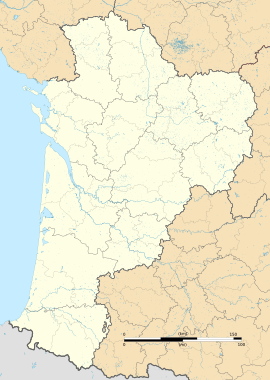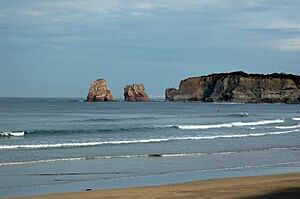Hendaye facts for kids
Quick facts for kids
Hendaye
Hendaia
|
||
|---|---|---|
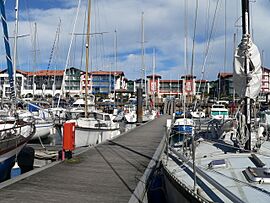
Hendaye harbour
|
||
|
||
| Country | France | |
| Region | Nouvelle-Aquitaine | |
| Department | Pyrénées-Atlantiques | |
| Arrondissement | Bayonne | |
| Canton | Hendaye-Côte Basque-Sud | |
| Intercommunality | CA Pays Basque | |
| Area
1
|
8 km2 (3 sq mi) | |
| Population
(2021)
|
17,796 | |
| • Density | 2,220/km2 (5,800/sq mi) | |
| Time zone | UTC+01:00 (CET) | |
| • Summer (DST) | UTC+02:00 (CEST) | |
| INSEE/Postal code |
64260 /64700
|
|
| Elevation | 0–108 m (0–354 ft) (avg. 25 m or 82 ft) |
|
| 1 French Land Register data, which excludes lakes, ponds, glaciers > 1 km2 (0.386 sq mi or 247 acres) and river estuaries. | ||
Hendaye (pronounced "ahn-DYE") is a town in southwestern France. It's located in the Pyrénées-Atlantiques department, which is part of the Nouvelle-Aquitaine region. The town is also known as Hendaia in Basque and Hendaya in Spanish.
This town is the most southwesterly place in mainland France. It's a popular spot for tourists who love the seaside. Hendaye sits on the right bank of the River Bidassoa. This river forms the border between France and Spain before flowing into the Atlantic Ocean. Hendaye is part of the French Basque Country.
Hendaye has three main areas:
- The town (la ville): This part stretches from Saint Vincent's church to the railway station and industrial area.
- The beach (la plage): This is the seaside part of town.
- The heights (les hauteurs): Here you'll find villas and camping sites on the hills between and behind the other two areas.
Contents
History of Hendaye
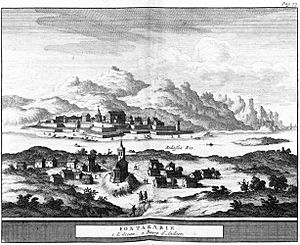
Hendaye became its own independent town, separate from the nearby Urrugne parish, in 1598. This happened when Saint Vincent's church was built. During the Franco-Spanish War, Spanish forces briefly took over the town in September 1636.
A very important event happened on Île des Faisans (Pheasant Island) in the river. In 1659, the Treaty of the Pyrenees was signed there. This treaty finally ended many years of fighting between France and Spain. What's cool about this island is that France and Spain take turns controlling it every six months!
However, the town often suffered damage from wars. In the War of the Pyrenees (1793–1795), Hendaye was almost completely destroyed. A writer named Wilhelm von Humboldt described it in 1799, saying that most houses were ruined and the area was covered in overgrown bushes.
The way people lived and traded across the border changed a lot after these wars. New laws and customs borders made it harder for the Basque-speaking communities on both sides of the Bidassoa river to connect easily.
A big change came on October 22, 1863, when the railway arrived in Hendaye. This connected the town to the rest of France and Spain. On August 15, 1864, the first train from Madrid to Paris arrived in Hendaye. This led to fast growth, and Hendaye became an important international hub and a popular seaside resort, much like Biarritz. In 1913, a Spanish Basque railway, nicknamed "topo" (the 'mole'), also reached Hendaye, connecting it to Donostia (San Sebastián).
On October 23, 1940, during World War II, a famous meeting took place at the Hendaye railway station. Adolf Hitler (from Germany) and Francisco Franco (from Spain) met there to talk about Spain joining the war with Germany. Franco decided not to join, which helped Spain avoid war with the United Kingdom.
Hendaye was also the birthplace of Martin Guerre, a French farmer from the 1500s who was involved in a very famous case of someone pretending to be him.
Population
| Historical population | ||
|---|---|---|
| Year | Pop. | ±% p.a. |
| 1968 | 8,006 | — |
| 1975 | 9,470 | +2.43% |
| 1982 | 10,572 | +1.59% |
| 1990 | 11,578 | +1.14% |
| 1999 | 12,596 | +0.94% |
| 2007 | 13,969 | +1.30% |
| 2012 | 16,759 | +3.71% |
| 2017 | 16,484 | −0.33% |
| Source: INSEE | ||
Places to See in Hendaye
The town square is a lively place where a weekly open-air market happens on Wednesdays. Here you can find the famous Great Cross of Hendaye. This stone cross from the 1600s has mysterious symbols carved into it. Some people believe these symbols hold secret messages about a future global event!
The church of Saint-Vincent was built in 1598. It has been rebuilt many times over the centuries because of fires and attacks. Its most recent changes were finished in 1968. The church's most valuable treasure is a crucifix from the 1200s.
You can also see the ruins of old fortifications from the early 1600s. These were made even stronger by a famous engineer named Vauban in 1685. The old cannons still face Hondarribia across the water. You can see these along the promenade by the Bay of Txingudi.
The Château d'Abbadie is a beautiful castle right by the sea. It was built for Antoine d'Abbadie by the architect Eugène Viollet-le-Duc. It's a great example of the Gothic Revival style, which brought back older architectural designs.
The Casino building was built in 1885 in a Neo-Moorish style, which looks a bit like buildings from North Africa or Spain. It used to be a casino, but now the casino is in a different part of town. During World War I, this building was used as a military hospital for soldiers.
The old fishing port of Caneta is very picturesque. From here, you can enjoy views over the Bay of Txingudi to Hondarribia and the Jaizkibel mountain. This is also where you can find the house of writer Pierre Loti and the old customs building.
The Jumeaux rocks (meaning 'The Twins') are a symbol of Hendaye. In Basque, they are called Dunbarriak, which means 'the bell stones'. These two tall rock formations have been shaped by waves hitting the cliffs. You can see them from the beach or from the Domaine d'Abbadia, which is a nature park.
Culture in Hendaye
Music Scene
Hendaye has many places where bands can play. The covered pelota court at Belcenia is a large venue, and the Basque folk band Oskorri has played there. In summer, bigger bands can perform outdoors at the Hendaye Plage Rugby pitch.
The Cinéma les Variétés is also a place where concerts can be held. The closed market is a good spot for new local bands to play smaller shows. During the summer, local bands often play at Hendaye's many campsites.
The Lanetik Egina music club is a central part of Hendaye's music scene. It's known for being a great place and often hosts concerts. It's also where musicians of all ages can meet and form bands. One of the most successful bands from Hendaye is the Basque ska-punk band Skunk, who have released many albums.
Theatre and Performances
The Cinéma les Variétés is a large, classic theatre and cinema. It regularly hosts theatre plays, dancing shows, and other performance arts. There's another cinema called the Salle Antoine d'Abbadie near the beach, but it's only used for special events. The Théâtre des Chimères from Biarritz often performs in Hendaye.
Art and Books
The Médiathèque municipale François Mitterrand is a public library. It offers books, magazines, films, and CDs for everyone to enjoy. It also has an art gallery, which is the main one in Hendaye.
Local Events
Here are some of the regular festivals and events in Hendaye:
- January: Bixintxo (St Vincent)
- May: Mai du théâtre (a theatre festival that lasts all month)
- June: Fête du cidre (a cider festival) and Fête de la musique (a music festival)
- July: Fête de la Mer (a festival celebrating the Sea)
- August: Fête Basque (a festival celebrating Basque culture)
Food and Drink
Most of Hendaye's restaurants are found near the beach and along the Bay of Txingudi waterfront. Hendaye is also well-known locally for its delicious txurros, which are a type of fried dough pastry.
Getting Around Hendaye
Hendaye is an important railway hub. This is because Spain's main trains use a wider track than trains in the rest of Europe. So, the French railway network ends here, right by the Bidasoa river. Besides the main Gare d'Hendaye station, there's also a station for the beach area called Gare des Deux-Jumeaux. The San Sebastián Metro, a rapid transit system, also connects Hendaye to Donostia-San Sebastián, arriving at the SNCF station.
There has been some discussion about a new high-speed train (TGV) line. This new line is planned to go inland, bypassing Hendaye completely. Many local people want the TGV to come to Hendaye, but they don't want a new line that would damage the countryside. They suggest upgrading the current line instead, which would also be cheaper and help the local economy.
Hendaye's Connections
Hendaye is part of the larger urban area of Bayonne. It's also part of the Communauté d'agglomération du Pays Basque, which is a group of towns working together. The area that Hendaye serves also includes two other towns: Biriatou to the south and Urrugne to the east.
Sister Cities
Hendaye has "twin towns" or "sister cities" in other countries. This means they have special friendly relationships. Hendaye is twinned with:
Famous People from Hendaye
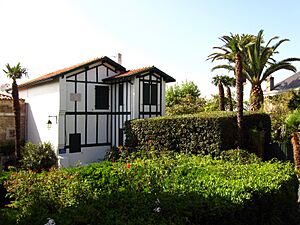
Many interesting people have connections to Hendaye:
- Antoine d'Abbadie, who built the famous Château d'Abbadie, lived here.
- Pauline Ado, a world champion surfer, was born in Hendaye.
- Robert Basauri, a rugby player who played for the French national team, was born here.
- Coqueline Courrèges, a dressmaker and co-founder of the Courrèges fashion company, was born in Hendaye.
- The professional rugby player Jean-Michel Esponda, who played for the French national team, was born here.
- Martin Guerre, the famous 16th-century peasant involved in a case of mistaken identity, was born in Hendaye.
- Ernest Hemingway, a famous American novelist and writer, lived in Hendaye in the late 1920s.
- Maurice Jouvet, a French-Argentine actor, was born here.
- Bixente Lizarazu, a well-known football player, grew up here.
- Pierre Loti, a famous French writer, lived and died in Hendaye. His house, called Bakhar-Etchea, still exists.
- Miguel de Unamuno, a Spanish writer and philosopher, moved to Hendaye in 1925.
Sports in Hendaye
Hendaye is a great place for sports and outdoor activities:
- It is the western starting (or ending) point of the GR 10, a very long walking path across the Pyrenees mountains.
- It also marks the start (or end) of the Raid Pyreneen, a challenging long-distance cycling event.
- The Endaika rowing club was started in 1889. They have won many medals, including a world championship gold medal in 2014.
- Hendaye has a rugby and handball club called the Stade Hendayais, founded in 1908.
- There is a football club called the Eglantins.
- The Bidasoa Surf Club is Hendaye's surf club. Hendaye is known for its gentle waves, which are perfect for beginner surfers.
- Since 2004, the world design center for the watersports brand Tribord is located in Hendaye.
- Hendaye has a large marina with 850 places for boats, making it the third largest in the Aquitaine region.
- Tennis players gather for a Summer tennis tournament in Hendaye.
See also
 In Spanish: Hendaya para niños
In Spanish: Hendaya para niños




